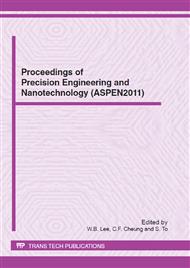[1]
M. Baker, Finite element simulation of high-speed cutting forces, J. Mater. Process. Technol. 176 (2006) 117-126.
Google Scholar
[2]
J.P. Davim, P. Reis, C. Maranhao, M.J. Jackson, G. Cabral, J. Gracio, Finite element simulation and experimental analysis of orthogonal cutting of an aluminium alloy using polycrystalline diamond tools, Int. J. Mater. Prod. Technol. 37 (2010).
DOI: 10.1504/ijmpt.2010.029458
Google Scholar
[3]
K. Khalili, M. Safaei, FEM analysis of edge preparation for chamfered tools, Int. J. Mater. Form. 2 (2009) 217-224.
DOI: 10.1007/s12289-009-0405-0
Google Scholar
[4]
A. Dhanorker, T. Ozel, Meso/micro scale milling for micro-manufacturing, International Journal of Mechatronics and Manufacturing Systems. 1 (2008) 23-42.
DOI: 10.1504/ijmms.2008.018273
Google Scholar
[5]
J.S. Wang, Y.D. Gong, G. Abba, J.F. Antoine, J.S. Shi, Chip formation analysis in micromilling operation, Int. J. Adv. Manuf. Technol. 45 (2009) 430-447.
DOI: 10.1007/s00170-009-1989-8
Google Scholar
[6]
S.M. Afazov, S.M. Ratchev, J. Segal, Modelling and simulation of micro-milling cutting forces, J. Mater. Process. Technol. 210 (2010) 2154-2162.
DOI: 10.1016/j.jmatprotec.2010.07.033
Google Scholar
[7]
M.A. Sheikh, P.T. Mativenga, S.A. Iqbal, Characterization of machining of AISI 1045 steel over a wide range of cutting speeds, Part 2: evaluation of flow stress models and interface friction distribution schemes, Proc. I. Mech. Eng. B: J. Eng. 221 (2007).
DOI: 10.1243/09544054jem797
Google Scholar
[8]
S. Jaspers, Material behaviour in conditions similar to metal cutting: flow stress in the primary shear zone, J. Mater. Process. Technol. 122 (2002) 322-330.
DOI: 10.1016/s0924-0136(01)01228-6
Google Scholar
[9]
W. Grzesik, Z. Zalisz, P. Nieslony, Friction and wear testing of multilayer coatings on carbide substrates for dry machining applications, Surf. Coat. Technol. 155 (2002) 37-45.
DOI: 10.1016/s0257-8972(02)00040-3
Google Scholar
[10]
D. Huo and K. Cheng. An experimental investigation on micro milling of OFHC copper using tungsten carbide, CVD and single crystal diamond micro tools, Proc. I. Mech. Eng. B: J. Eng. 224 (2010) 995-1003.
DOI: 10.1243/09544054jem1828sc
Google Scholar


